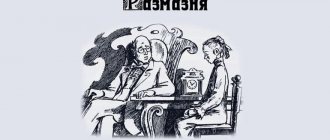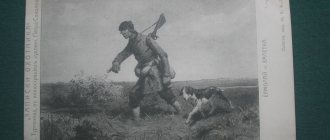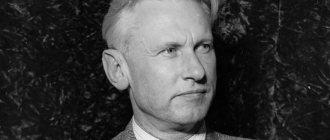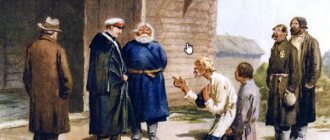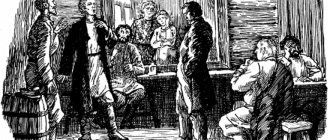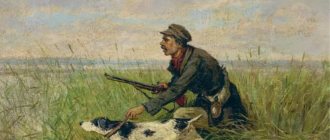History of creation
A.P. Chekhov wrote the story "Kashtanka" in 1887. It was subsequently published in the newspaper “Novoe Vremya”.
There are different versions about what prompted the writing of this story. According to one of them, the story “Kashtanka” is autobiographical and based on the story of the trainer Vladimir Durov, as evidenced by the revelations in his book “My Animals”. Also, perhaps A.P. Chekhov could have been inspired by stories from the writer N.A. Leikin or from a school friend E.T. Efimiev.
“An incident with a dog, similar to the one described in the story, was reported to Chekhov by the famous circus artist V. Durov. Chekhov loved the circus and often visited it not only at the performances, but also behind the scenes. At the circus he also met the learned goose Ivan Ivanovich. Chekhov always had pigeons, cats and dogs in his house, and at one time there even lived a tame crane. He gave his two dachshunds funny nicknames - Brom and Hina. Chekhov loved animals and spoke wonderfully about them.” (introductory article from the book “Stories. Chekhov A.P.”, DETGIZ publishing house, Moscow, 1950)
Conclusion
“Kashtanka” is, in a sense, an ode to dog fidelity. The author pushes the reader to the idea that animals deserve happiness no less than people, and causing harm to a living creature is unforgivable cruelty. He wholeheartedly sympathizes with the dog, who cannot leave a callous and evil person simply because she loves him madly. Alas, today we are faced with cruelty towards domestic animals: thousands of dogs and cats are forced to wander the streets in search of food. But many of them once had their own home...
Genre, direction
The work “Kashtanka” rightfully belongs to the genre of short story. Chekhov is truly a creator of short prose. It’s not for nothing that many critics claim that before A.P. Chekhov's stories as such did not exist.
“Kashtanka” belongs to the “realism” direction. A.P. Chekhov uses psychologism in the story, that is, he shows the inner world of the hero. In other words, we trace all of Kashtanka’s feelings and experiences, thereby penetrating into the animal world.
The gist: what is the story about?
Kashtanka lived with a worker and his son, who often beat and did not feed their pet. But now the dog is lost and is looking for its owner, whose trail it cannot find.
Having fallen asleep near the entrance, Kashtanka finds a new owner. He takes care of her and trains her to become a circus performer. Soon Kashtanka makes friends and gets used to her new home. One day at a performance, Kashtanka hears familiar voices. It was her old owner Luka Alexandrovich and his son. Kashtanka runs towards them. She returns home and forgets about the other owner, like a prolonged dream.
Kashtanka
Kashtanka, a young red dog, a cross between a dachshund and a mongrel, wanders along the street and tries to find her owner. Its owner, carpenter Luka Aleksandrovich, has disappeared, and the animal cannot pick up his trail.
When it gets completely dark, the crying Kashtanka falls asleep near the entrance. She wakes up from the sound of the door opening. The person who opens the door calls the dog to his home, where he feeds it and gives it a small mattress for the night. So Kashtanka gets a new owner.
Continued after advertisement:
Waking up, Kashtanka begins to explore her new home. Behind one of the doors there is a small room with dirty wallpaper. In this room, the dog encounters a goose and a cat. They start hissing at her. A small scuffle occurs, as a result of which Kashtanka receives a paw on the head from the cat, and a blow to the back from the goose with its beak. The chaos is stopped by the owner suddenly appearing. At his command, the animals calm down and take their places.
A little later the man returns and brings a strange thing in the shape of the letter P, on the crossbar of which hangs a bell and a pistol is tied. At the man’s command, the goose Ivan Ivanovich begins to perform various tricks, which the dog watches in fascination. Then the owner calls Khavronya Ivanovna, and a black, very ugly and very good-natured pig appears in the room. The next trick, called the “Egyptian pyramid,” is performed by the goose together with the pig and the cat Fyodor Timofeevich. From this moment on, Kashtanka begins to live in this room in the company of Ivan Ivanovich and Fyodor Timofeevich, and the dog itself receives a new name - Aunt.
A month passes. The owner says it’s time for her to learn. He wants to make an artist out of the dog. The classes are going well, Kashtanka easily does everything they want from her. A satisfied man notes the talent of his new ward.
One evening, Kashtanka is trying to sleep, but then the cry of a goose is heard. The owner comes and it turns out that a horse stepped on the goose during the day. Ivan Ivanovich is dying. The death of a goose upsets a person very much, and tears come to his eyes. Auntie and Fyodor Timofeevich, not understanding anything, huddle close to the man.
One fine evening the owner takes his dog and cat with him. He understands that nothing is rehearsed and is prepared for failure in advance. A man brings animals to the circus, where he himself works as a clown under the pseudonym Mister Georges. In the dressing room, he changes into a clown suit, puts the cat and dog in a suitcase and goes out into the arena. The performance begins.
Briefly exists thanks to advertising:
Mr. Georges commands the dog to sit down, which she does, and invites Fyodor Timofeevich to dance, then the clown begins to play the pipe, and the dog is given the role of a singer, howling to her accompaniment. During a particularly high note, someone in the audience gasps in surprise. This is the former owner Luka Alexandrovich along with his son Fedyushka. They start calling Kashtanka by her old name, and she runs towards them.
Half an hour later, Kashtanka walks down the street behind her old owners, who smell familiarly of glue and varnish.
The main characters and their characteristics
The heroes of the story “Kashtanka” are listed by the Many-Wise Litrecon in the table:
| heroes of the story "Kashtanka" | characteristic |
| chestnut | she is not just a young red dog, but a living creature with her own feelings and experiences. a.p. Chekhov gives her human qualities: rationality, prudence, kindness, devotion. Kashtanka is a guide to the world of people, because through her eyes the essence of what is happening is conveyed. she knows how to love, make friends, support and be faithful to her owner, despite his rudeness and negligence. in the animal world she experiences likes and dislikes, but strives to live in peace with everyone; |
| stranger | he trains animals and works in a circus. he teaches all his animals to live together and sincerely cares about them. he is kind, affectionate and attentive. spares neither food nor time for pets; |
| white cat Fedor Timofeich | This is a character who has little interest in life except sleep. he doesn’t like to learn tricks, so he does everything lazily; |
| Goose Ivan Ivanovich | he talks too much and is unclear, which is why not everyone can listen to him; |
| Luka Aleksandrych | he works hard to support his family. he takes poor care of the chestnut, feeds it poorly and even kicks it. rudeness coexists in his soul with affection. he loves the dog and cannot hide his emotions when he meets her again. |
Summary
The main character of the story is the dog Kashtanka, a cross between a dachshund and a mongrel. She is loyal and, according to the description, very pretty, but she is forced to wander the streets because she has lost her owner - carpenter and alcohol lover Luka Alexandrovich. Freezing and hungry, a stranger took her in. He warmed her up, fed her, and in her sleepy half-oblivion, Kashtanka remembered her former life. She no longer knew where she was better off, in the old or new place.
In the morning, the dog met other inhabitants of the new house - a goose named Ivan Ivanovich, a cat Fyodor Timofeevich and an ugly young black pig called Khavronya Ivanovna. From the new owner she received the nickname Aunt.
It soon becomes clear that the owner keeps the animals for a reason. He teaches them tricks and makes money from it. For three months he took care of Kashtanka, fed and groomed her. There was no trace left of the emaciated animal; the dog with a fox face became well-groomed and cute. Anticipating talent in her, the owner (the clown Georges) taught her tricks that caused delight. However, not everything is smooth in a small team. Gus Ivan Ivanovich was injured (a horse stepped on him) and gradually faded away.
The time has come for the first performance, which, by coincidence, was attended by the former owner of Kashtanka with his son Fedyushka. They recognized Kashtanka and called her. Forgetting about the performance, the dog rushed towards his dear people. Warmth, delicious food, a satisfying life, career heights - everything was left for the sake of them, albeit unlucky, but very dear people. The summary of the work can be contained in 6 sentences:
- A regiment of soldiers passed by the tavern where Kashtanka was waiting for the owner, she was frightened by the sounds, rushed about and got lost.
- A stranger picked up a dog in poor condition.
- Meeting the goose and the cat, watching their rehearsal.
- Getting the nickname Auntie and learning magic tricks, the death of a goose that fell under the hooves of a horse.
- Training in the circus, preparing a stage act for a debut performance.
- Entering the arena, a joyful meeting with the old unlucky owner.
Themes
The theme of the story “Kashtanka” is very relevant today:
- The main theme of the story “Kashtanka” is the interaction between people and animals
. Another important topic also follows from this - the attitude of people towards animals. A.P. Chekhov specifically looked at the world through the eyes of a dog in order to show the reader his portrait from the outside. Alas, the picture is bleak: pets give us love and loyalty, and in return we kick and torture them. Chekhov calls on you to be more attentive and kinder to your pets. They are also alive and feel pain, hunger, melancholy. - Another theme is devotion
. Despite the poor treatment, Kashtanka returned to her owner. Neither good food, nor fame, nor the affection of the new owner seduced the loving dog. - Love
is also a topic for Chekhov's thoughts. It can be different: even Luka, a rude and indifferent worker, is attached to his pet in his own way.
Problems
The problematics of the story “Kashtanka” are just as interesting to think about:
- Inattention and irresponsibility
towards our smaller brothers. "We are responsible for those we have tamed." It is important to remember those whom we have taken under our wing and to appreciate their loyalty. This is exactly what Luka Alexandritch did not do; - Mutual assistance and indifference
. The willingness to lend a hand in times of need is an important human character trait. This is expressed in the stranger who takes Kashtanka to him. Being a truly kind person, he does not expect anything in return. But the dog's real owners lost it, but did not take the initiative to find it. This attitude towards a pet is unacceptable.; - Sympathy and callousness
. The ability to empathize with others is an essential quality of any living being. When Auntie sees the trainer's tears over the loss of the goose, she sincerely sympathizes and cannot hide her emotions. But callousness is presented by the author as a very serious vice. The owner's son hurts the dog, but does not understand its suffering at all.
main idea
The meaning of Chekhov's story "Kashtanka" is the importance of devotion and love in the relationship between man and animal. Kashtanka is the personification of all this. She ends up with a trainer, where she is well fed and looked after, but she remains truly faithful to her former owner, although he was the complete opposite and did not particularly show his love. People, according to the author, should strive to become worthy of such adoration.
In addition, the author shows us that people and animals are capable of living together, loving each other. At a stranger’s home, harmony reigns; they know how to empathize, support, and care. The main idea of the story “Kashtanka” is the author’s passionate appeal for humanism and respect in relations between people and animals.
What does it teach?
A.P. Chekhov puts a certain moral into the story “Kashtanka”, namely the importance of understanding what the relationship between people and animals should be. There is no place for indifference and oppression; there should be only loyalty, sincerity and care. Animals need all this, just like people. However, people need to remember to appreciate the loyalty of their little friends so as not to lose them.
Chekhov's conclusion is simple: give love to those who are close to you, because they answer you in kind. The same Kashtanka deserves love and care, and not kicks from her owner. He did not appreciate her devotion, but in vain, because the animal is superior in its loyalty to many anthropoids.
Notes
- Newspaper "New Time". - 1887. - December 25. - No. 4248. - P. 1-2.
- Durov V.L.
My animals. - M.: Young Guard, 1927. - P. 59. - Chekhov A.P.
Collection of articles and materials. Vol. 3. - Rostov-n/D.: Rostov-n/D: Rost. book publishing house, 1963. - Chekhov A.P.
Kashtanka. Notes. - ↑ 123
Notes to the story “Kashtanka” // Chekhov A.P. Complete works and letters: In 30 volumes. Works: In 18 volumes / USSR Academy of Sciences. Institute of World Lit. them. A. M. Gorky. - M.: Nauka, 1974-1982. T. 7. [Stories. Stories], 1888-1891. - M.: Nauka, 1977. - P. 340-352.

